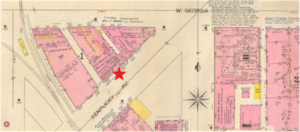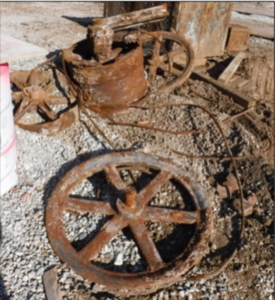Published September 8, 2023
Going Up! The Archaeology of Elevators
As we give tours through the archaeology collection at the Indiana State Museum and Historic Sites; showcasing 2,000-year-old Native American pottery, ancient spear points, beautiful historic ceramics, and a wide variety of sites from throughout the state, guests’ attention is frequently captured by an unassuming, large, heavy, rusted, square piece of iron and they ask, “What is that?” To which we answer, “That object is one piece of a very uplifting story — it’s part of an elevator.”
The humble elevator is something many of us take for granted. Sure, they save us countless steps, but do we really take notice of them until they are out-of-order, and they really let us down? Do we ever wonder about their history and use in the past? Imagine life without them. Do you think we would have the skylines we have today without them? The elevator allowed property owners, developers, and businesses to go in a new direction — up.
Indianapolis in the late 19th and early 20th century was home to several elevator companies and manufacturers: C.H. Mitchell & Co., Nordyke & Marmon Co., Olaf R. Olsen, H.J. Reedy Elevator Co., Pneumatic Elevator and Weigher Co., O Wm. Server, and many others as they came and went.
One of those was the Parkhurst Brothers Manufacturing Company located at 218 Kentucky Ave. Hall H within the Indiana Convention Center occupies that address today, but at the turn of the 20th century this was a busy industrial hub within the city.

You might ask, “How was the elevator business at Parkhurst around 1895?” Well, it had its ups and downs.
While business was good, they had to deal with several industrial fires causing thousands of dollars of damage. They also had no room for expansion. Parkhust began looking for new opportunities, and in 1906, they moved their company to the new Oakdale industrial development outside of Peru. Here, they built a new factory as they continued their ascent in the elevator industry. Parkhurst operations continued until the company was sold to the Otis Elevator Company in 1909 but Otis closed the Peru factory in 1912.

What makes this short time in Peru interesting is that between 1906 and 1909, Parkhurst installed an elevator in the 200 block of East Washington Street in Indianapolis, which is the current site of IndyGo’s Julia Carson Transit Center. Archaeological excavations took place in 2015 prior to the transit center’s construction, and archaeologists discovered the remains of the elevator, including the weight. Although much of the elevator remained, due to size, weight and conservation needs, only the counterweight with name plate was preserved.
The location where the machinery was found during excavations is near where an elevator is marked on the 1898 Sanborn map. This raises the question, did Parkhurst replace the older elevator from 1898 between 1906 and 1909?

During the early 20th century, most of this block was home to Sander and Recker Furniture Company, who manufactured their furniture onsite. According to their ads, Sander and Recker made a wide range of furniture, from beds, dressers, sofas, parlor sets, to sleeper sofas, chairs and more. Their employees were probably happy to use an elevator to move these large pieces of furniture.

Although we would love to say with definitive proof that our elevator weight is from this exact spot, we can’t. As the map also shows, other elevators were located throughout the block. Without detailed construction records or information on how the buildings were demolished, we cannot rule out that our elevator isn’t from one of these other locations. When trying to match Sanborn maps with archaeological excavations, there can be some uncertainty. However, these large pieces of industrial archaeology provide us a clue into how technology improved the ability of companies to conduct business within the old commercial zone in Indianapolis. It can provide insights into the use of labor and the time/labor saving tools they used. It also shows the interconnectedness of industries within Indianapolis and Indiana. It demonstrates how one company’s rise can help another’s climb to the top of their market.
-

The manufacturer’s name plate on the weight. “Manufactured By, Parkhurst MFG. Co., Peru, IND. U.S.A.”
-

The square block portion of the weight is 9” x 7” x 6.5.” Note the cables which attached the weight to the rest of the equipment.
-

Elevator ad from the 1899 Indianapolis city directory.
-

Additional remains of the elevator included the sheaves, cables, and braking mechanism. Based upon the parts, the elevator looks like a freight elevator featured in a 1905 Parkhust advertisement.









